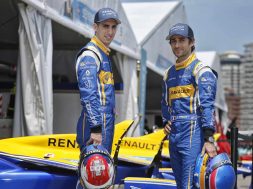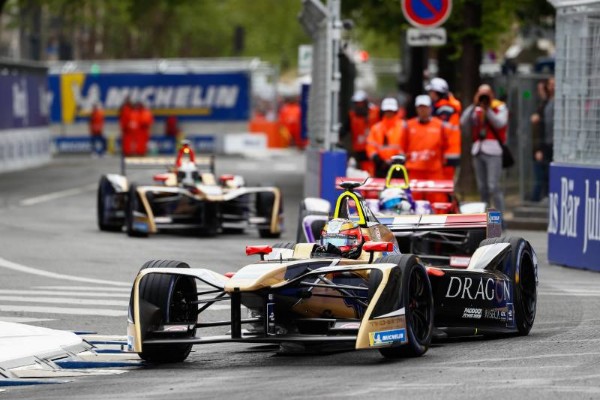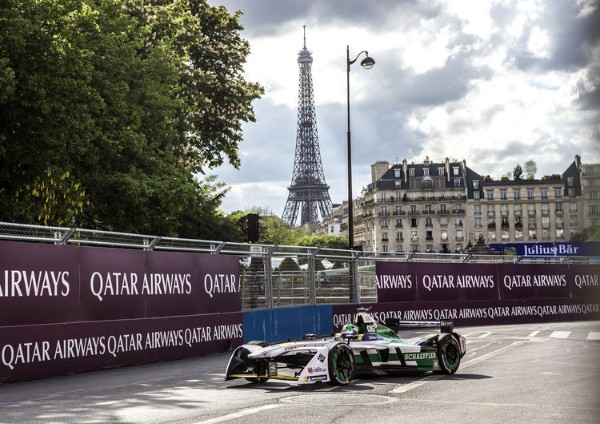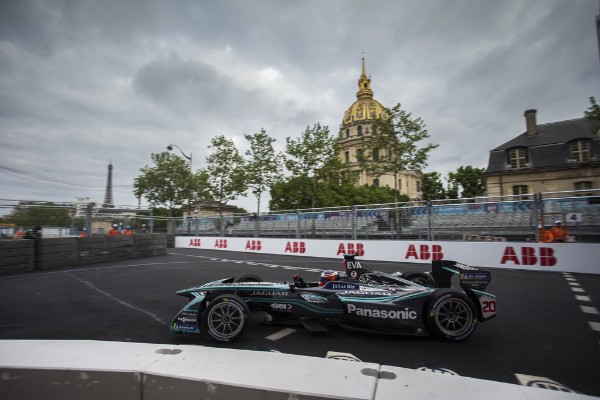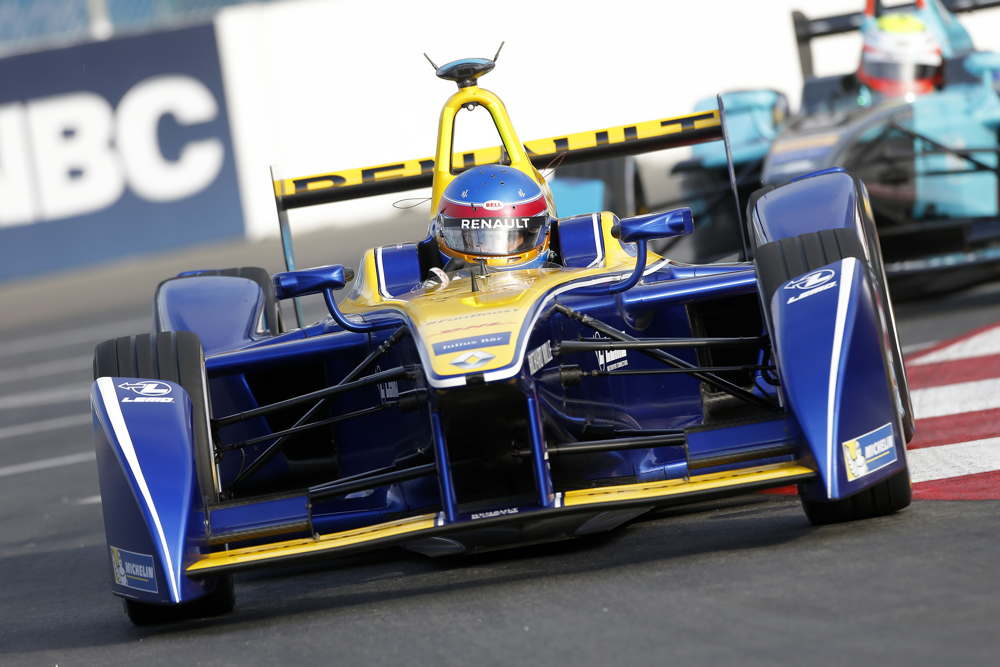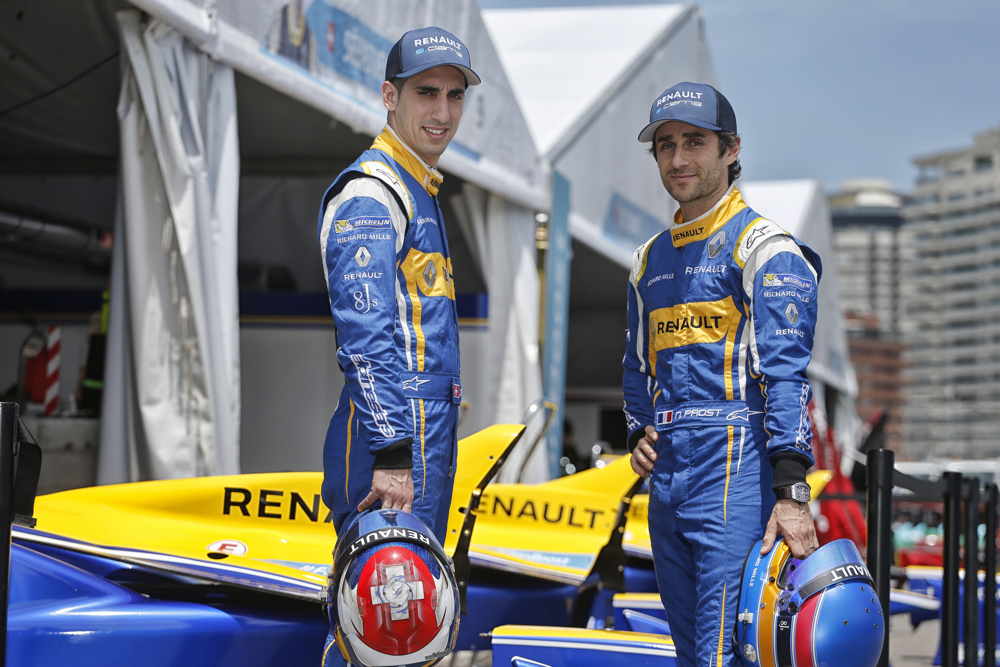Championship leading Renault e.dams looks to return to winning ways in its home race when the FIA Formula E Championship takes to the streets of Paris for the first time with the Formula E Visa Paris ePrix on April 23.
For the seventh round of the 2015/16 season the French capital is the location with a 1.93km bespoke street course formed around Les Invalides, featuring fourteen turns and a clockwise configuration.
The previous outing at Long Beach, California, was a frustrating event for the squad with strong pace – including the race’s fastest lap – not translating to solid results after a race incident and subsequent penalty for Sebastien Buemi and also a penalty for Nico Prost.
Despite Nico finishing the race in eleventh and Sebastien in sixteenth, Renault e.dams maintains the lead in the teams’ championship, with Renault’s 138 points putting them six clear of Audi Sport ABT. However, the German team’s resurgence in America means Lucas di Grassi now leads Buemi in the drivers’ championship by a solitary point.
The Californian disappointment highlights the high standards within the team, with Sebastien taking earlier victories in Beijing and Punta del Este, as well as podiums in Buenos Aires and Mexico. Nico meanwhile hit a good vein of form to boost the team’s points total. After retiring in Beijing and taking tenth in Putrajaya, the Frenchman has finished inside the top five in three of the last four races, including a third place in Mexico.
The team’s Z.E.15 race cars headed to Donington Park following the Long Beach event to be stripped down and evaluated, this being the only occasion during the course of the season that the cars go back to base as opposed to heading to the next event.
The Paris ePrix is of particular importance for Renault, which has been a pioneer in EV technology. The Renault-Nissan Alliance was the first constructor to invest heavily in EV in 2009 and Renault is now the leader in the field with a 23.6% market share in Europe (2015). More than 18,500 ZOE cars have been sold across Europe, making it the best-selling EV on the market, while more than half the electric cars on the road in France are Renault vehicles.
Renault has used its involvement in Formula E to develop the innovative range of EV cars, including the ZOE, Twizy, Kangoo and Fluence Z.E. The Twizy engine, for example, was developed on the dynos in Viry-Châtillon, the nerve centre of Renault Sport motorsport engine operations. Future projects will likewise utilise the resources at both Viry and Enstone, the chassis technical base for Renault Sport.
All action for the Visa Paris ePrix takes place on Saturday 23 April.
Views from the team
Alain Prost – Senior Team Manager:
It’s a big event for us in Paris, we’re a French team and we’re Renault so there is expectation. We also have more pressure because of our poor results last time out. We know our goal, which is to bounce back with a strong performance. The pressure and expectation is not always easy to manage and you have to channel this into being a positive pressure to perform at the very best level. We realise that the competition is getting closer and closer and in this case we need to do things right and to be honest we just didn’t do that in Long Beach.
Jean-Paul Driot – Senior Team Manager:
From my perspective the aim is, of course, to win in Paris. The cars have been checked over, the drivers have had many debriefs and assessed their performances and the team have gone over the weekend in Long Beach to ensure we are better prepared than ever for Paris. We want to be back in the position we know we should be in.
Vincent Gaillardot – Renault Sport Project Leader:
It’s the midpoint of the season so the focus has been ensuring that the cars really are the very best they can be to ensure Sebastien and Nico can achieve the strongest results possible. After Long Beach the cars went back to Donington for a thorough evaluation and rebuild and we feel confident we can return to the strong results we saw earlier in the year.
Nico Prost:
I’m obviously looking forward to Paris as it’s a massive honour to drive in your home country, I’m sure it will be a fantastic experience. The event is important for motorsport in France. I hope it’ll be a great experience for everyone who sees it and for us lucky drivers who get to compete in it.
It’s good to be showcasing this style of racing and it’s very important for Formula E to race in cities as that’s where they can be used. France is doing a very good job of pushing for electric cars, Renault is pushing hard for it too. It’s an event that makes sense politically and commercially to show the importance of electric cars with such a fabulous backdrop.
Sebastien Buemi:
After Long Beach stop and reset was my plan. I did make some mistakes and I lost the lead of the drivers’ championship. Clearly I want to regain that lead for myself and help Renault e.dams to extend their lead in the teams’ championship. The team have spent a lot of time working on the cars and I’ve been working with my engineers to have a strong approach to Paris. We want a strong result.
It’s going to be an amazing feeling to race in Paris and there’s going to be pressure. It’s our home race, so we’re looking forward to being there and enjoying it with the fans. It’ll be the biggest race of our season. It’ll be a tough track, there’s a lot of corners and it’s tight and slow. It’s tough to know until we drive it but I’m very motivated.
Renault e.dams Feature
A better race car for a better world?
Motorsport might not be the first endeavour that comes to mind when thinking of pushing developments with the aim of benefitting the environment, however Renault Sport Project Leader Vincent Gaillardot explains why Renault’s involvement with the Renault e.dams team does bring rapid benefits.
Why motorsport?
The motorsport development cycle is much quicker than the development cycle for road cars. We can implement new technology and test new features with very quick evaluation processes, this is the primary area where motorsport brings value relative to road car development.
We are dealing with new technology and new concepts and there is a stronger link than in other motorsport categories between what we are doing for the race cars and the concepts which are relevant for the electric road cars. We all benefit from the programme and the lessons learnt.
What changes and improvements have been seen from season one to season two?
For this season thanks to the regulation changes we’ve been able to implement our own architecture for the powertrain and for the motor and gearbox and this freedom has made our work more relevant for the road car development as we can explore different architecture options to explore the best efficiency. The efficiency gives us the best results on the track, but for the consumer it gives the best range and performance from the battery which consequently means the best use of energy and therefore the most positive outcome for the environment.
What can we expect for season three?
We made a big step through developing our own architecture for the current season so for season three the focus is more on the optimisation of this architecture as the concept is good, but there are further areas where we can make significant gains.
Where can gains be made?
We are power and energy limited by the regulations so the main area of competitive endeavour is in efficiency. The team who can be the most efficient with the energy at their disposal will be the team who wins. The more efficient you can be, the greater the potential benefit to road cars. The aim is to get to as close as possible to 100% efficient. There’s still some way to go, but this is what drives us.
More specifically, what are you looking at?
Motor inverter technology is our primary area of focus currently. This is where there are gains to be made and the technology transfer is two-way here. We work closely with the motor inverter suppliers for our road cars so we can compare the technology we are using and the results we gain. This means we have two paths of development which are complementary. Whatever the purpose of electrical vehicle usage, efficiency and efficiency gains are king. For road cars the main goal is to extend the mileage range, whereas for Formula E it’s more about extracting the maximum performance over the race stint. We want higher efficiency to be quicker, they want higher efficiency to go further, but the means to achieve these different aims are very similar with technology implementation. It’s a very exciting and worthwhile area of development.
